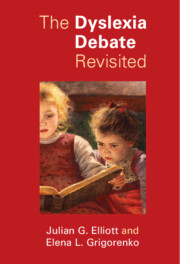67 results
10 - Cognitive Individual Differences
-
- Book:
- A Practical Guide to Second Language Teaching and Learning
- Published online:
- 03 May 2024
- Print publication:
- 30 May 2024, pp 214-238
-
- Chapter
- Export citation
Chapter 1 - What Is Dyslexia?
-
- Book:
- The Dyslexia Debate Revisited
- Published online:
- 30 March 2024
- Print publication:
- 18 April 2024, pp 1-61
-
- Chapter
- Export citation

The Dyslexia Debate Revisited
-
- Published online:
- 30 March 2024
- Print publication:
- 18 April 2024
A survey involving secondary students with dyslexia studying Latin or a modern foreign language
-
- Journal:
- Journal of Classics Teaching / Volume 25 / Issue 50 / Autumn 2024
- Published online by Cambridge University Press:
- 27 February 2024, pp. 191-197
-
- Article
-
- You have access
- Open access
- HTML
- Export citation
11 - Language and Literacy
-
- Book:
- Fundamentals of Developmental Cognitive Neuroscience
- Published online:
- 11 January 2024
- Print publication:
- 01 February 2024, pp 349-378
-
- Chapter
- Export citation
Chapter 5 - Reading Skill Development, Dyslexia, and Cognitive Neuroscience
-
- Book:
- The Psychology of Reading
- Published online:
- 04 January 2024
- Print publication:
- 18 January 2024, pp 129-167
-
- Chapter
- Export citation
7 - How do I best support neurodiverse language learners?
- from Part II - Differentiation
-
- Book:
- The Art and Science of Language Teaching
- Published online:
- 21 December 2023
- Print publication:
- 21 December 2023, pp 93-106
-
- Chapter
- Export citation
Epilogue
-
- Book:
- Cognitive and Emotional Study Strategies for Students with Dyslexia in Higher Education
- Published online:
- 14 September 2023
- Print publication:
- 28 September 2023, pp 425-426
-
- Chapter
- Export citation

Cognitive and Emotional Study Strategies for Students with Dyslexia in Higher Education
-
- Published online:
- 14 September 2023
- Print publication:
- 28 September 2023
5 - Bilingualism and Atypical Development
-
- Book:
- Bilingualism Matters
- Published online:
- 29 June 2023
- Print publication:
- 20 July 2023, pp 75-97
-
- Chapter
- Export citation
Association of sociodemographic, proximal, and distal clinical factors with current suicidal ideation: Findings from a nonclinical sample of young adults
-
- Journal:
- European Psychiatry / Volume 66 / Issue 1 / 2023
- Published online by Cambridge University Press:
- 27 February 2023, e29
-
- Article
-
- You have access
- Open access
- HTML
- Export citation
5 - Ireland: Tempered Acceptance
-
- Book:
- Language Policy and the New Speaker Challenge
- Published online:
- 02 February 2023
- Print publication:
- 09 February 2023, pp 154-211
-
- Chapter
- Export citation

The Cambridge Handbook of Dyslexia and Dyscalculia
-
- Published online:
- 28 July 2022
- Print publication:
- 28 July 2022
Chapter 8 - Dyslexia, Attention-Deficit Disorder, and the Creative Trance
-
- Book:
- The Creative Trance
- Published online:
- 02 June 2022
- Print publication:
- 09 June 2022, pp 112-129
-
- Chapter
- Export citation

Dyslexia in Higher Education
- Anxiety and Coping Skills
-
- Published online:
- 21 October 2021
- Print publication:
- 04 November 2021
Do podcasts improve the learning experience of dyslexic medical students?
-
- Journal:
- European Psychiatry / Volume 64 / Issue S1 / April 2021
- Published online by Cambridge University Press:
- 13 August 2021, p. S594
-
- Article
-
- You have access
- Open access
- Export citation
Inventory construction to track cognitive profiles compatible with intellectual disability, ADHD, and dyslexia in children between 6 to 11 years old
-
- Journal:
- European Psychiatry / Volume 64 / Issue S1 / April 2021
- Published online by Cambridge University Press:
- 13 August 2021, p. S755
-
- Article
-
- You have access
- Open access
- Export citation
A network approach to dyslexia: Mapping the reading network
-
- Journal:
- Development and Psychopathology / Volume 35 / Issue 3 / August 2023
- Published online by Cambridge University Press:
- 27 July 2021, pp. 1011-1025
-
- Article
-
- You have access
- Open access
- HTML
- Export citation
Grammatical performance in children with dyslexia: the contributions of individual differences in phonological memory and statistical learning
-
- Journal:
- Applied Psycholinguistics / Volume 42 / Issue 3 / May 2021
- Published online by Cambridge University Press:
- 08 April 2021, pp. 791-821
-
- Article
- Export citation
15 - Neurolinguistics
- from Part 7 - Language, Cognition, and the Brain
-
-
- Book:
- Introducing Linguistics
- Published online:
- 22 April 2021
- Print publication:
- 21 January 2021, pp 535-570
-
- Chapter
- Export citation


